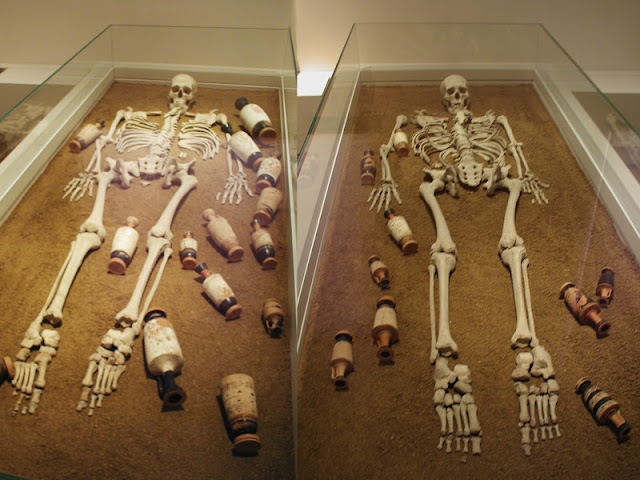Kotzia Square is a square in central Athens, Greece. The square retains several charactertics of 19th century local neoclassical architecture, such as the City Hall of the Municipality of Athens and the National Bank of Greece Cultural Centre. In the middle of Kotzia square classical antiquities have been recently uncovered that include a large part of an ancient road, tombs and a small building. The square is situated just outside of the ancient Acharnean Gate of Classical Athens.
The archaeological site at Kotzia Square yielded many important archaeological finds. It is located directly outside the ancient city’s fortification, part of which were also revealed and is currently preserved in front of the National Bank of Athens building and at the Aiolou pedestrian precinct. Excavations revealed three ancient streets, a dense cemetery dating from the Protogeometric period (ninth century BC) until the Late Roman period (third century AD), a large complex of pottery workshops of the Late Roman period (late third - fourth century AD), and several houses.
Part of the famous Acharnean Street, which began at the city gate (currently in front of the National Bank of Greece building) and led towards the northern demes of Attica, occupies the centre of the archaeological site. Stratigraphical evidence indicates that the street was laid out in 480 BC and was widely used throughout the fifth century BC.
The cemetery stretched on both sides of Acharnean Street. The grave gifts found in association with burials and cremations cover a wide time span. They include all manner of terracotta vases, some of them by famous ancient pottery workshops, human and animal figurines, glass and terracotta unguentaria, bronze mirrors, gold jewellery, coins, and other objects. A large number of sculptures from funerary monuments, such as columns, pillars, and marble vases, were discovered throughout the excavated area. Many of these were inscribed with the names and origin of those buried in the cemetery.
During the second half of the third century AD, after the devastating invasion of Athens by the Heruli, the cemetery fell into disuse, and a large complex of pottery workshops covered much of its area. The workshops operated during the fourth century AD, a period of prosperity for Athens. Archaeological finds from inside and around the pottery kilns show that they produced vases, domestic utensils, lamps, roof tiles, and antefixes.
The excavations at Kotzia Square were conducted in 1985-1988 during the construction of an underground car park and covered an area of 7,000 square metres. Additional investigation took place near the car park’s entrance and exit points in 1998-1999. Parts of the excavated area were conserved and fenced in 2003-2004, and are now accessible to visitors.
This post is part of Julie's Taphophile Tragics meme,
and also part of the Our World Tuesday meme.
 |
| Kotzia Square flanked by the neoclassical National Bank buildings |
 |
| One of the National Bank of Greece buildings on the square |
 |
| City Hall and Mayor of Athens office |
 |
| Part of the excavated ancient road |
 |
| The archaeological site of Kotzia Square |
 |
| Part of the ancient cemetery with remnants of the ancient city walls |
 |
| The graves are all lined with large blocks of stone |
 |
| An ancient memorial to "Ermagoras, son of Timon" |
 |
| In the National Archaeological Museum of Athens one may see human remains with funerary offering vases. these have been recovered form ancient graves |



Wow, that would be real old! I am amazed that most of the bones are still intact!
ReplyDeleteWonderful shots. I like old ruins. Those buildings are very impressive.
ReplyDeleteTo unearth so much surviving structure and artefacts in spite of the barrage of modern construction is amazing! Fascinating post!
ReplyDeleteThere is more there I am sure. Great read.
ReplyDeleteWonderful excavations, but then, Athens is full of them. Thank you for bringing them to us
ReplyDeleteHello Nick.
ReplyDeleteGreat pictures you show.
The image with the skeletons are "a little" creepy.
Wishing you a good day.
Hanne Bente / hbt.finus.dk
How fascinating to see this archaeological site in the middle of town!
ReplyDeleteI hope they keep on digging! Great stuff.
ReplyDeleteAmazing to think that, but for the underground car park, these archaeological finds might still be waiting to be discovered. Your photographs not only give us a great feel for the area, but they are works of art as well. i really enjoyed this post!
ReplyDeletethat is old!!
ReplyDeleteand im already amazed by the 100/200 year old graves around here...
Reading your post, I get a similar feeling to that when I visited Rome and its antiquities. I spent much of the time shaking my head, I guess at the wonder of it all. But also, too, at the imperative that these areas and these remains (both human and otherwise) should be protected, and it is the responsibility of the entire world, not just of Athens/Greece or Rome/Italy. I felt something similar when travelling through southern France. There is so much there that is of value from earlier centuries, that the government of France has to CHOOSE what it will protect/restore and the rest just falls down around their ears.
ReplyDeleteI do like the large stone 'coffins' in your photographs. It does not leave a lot to the imagination.
Wow! I love the stone lined graves, very striking.
ReplyDeleteHerding Cats